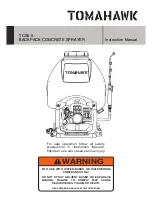
6
English / USA
SG 10
THE USE OF THE SPRAYER
Transporting the Sprayer
Empty container when transporting it in
a vehicle; properly secure it to prevent
damage to the unit.
Filling the Container
Before using the sprayer with chemicals,
fill it with fresh water to assure that you
have it properly assembled; pressurize it
and practice spraying. Also, check for
any leaks at this time. When thoroughly
familiar with the sprayer operation,
follow normal operating procedures.
Fill your sprayer in well-ventilated areas,
outdoors.
!
Warning!
Do not use:
–
flammables in the sprayer, which
can explode causing serious or fatal
injury;
–
caustic or corrosive materials in the
sprayer, which could result in
damage to the unit; sprayer
–
liquids with a temperature above
120 °F (50 °C) to avoid scalding and
damage to the unit. Do not leave
pressurized sprayer in the hot sun
or near any heat source.
To fill the sprayer, place it on a level
surface. To reduce the risk of
contaminating the surrounding
environment, be careful not to overfill the
container with chemical solution.
If you fill the container with a hose
attached to a central water supply, be
sure the end of the hose is out of the
solution to reduce the risk of backflow,
i.e. the chemicals being sucked into the
water supply in the case of a sudden
vacuum.
Calculate the correct amount of
chemical solution so that it is used up at
one time, with no extra solution left in the
container.
!
Warning!
To reduce the risk of personal injury and/
or property damage from solutions that
are too strong, make sure that chemicals
that require dilution are diluted properly.
When filled to the maximum mark, the
tank contains approximately 0.42 gal.
(1.6 l). See the Specifications for the
exact amount.
!
Warning!
Check for leakage while refilling and
during operation. A leak from the
container or a loose fitting could soak
your clothing and come into contact with
your skin.
Before Spraying
!
Warning!
Always inspect your sprayer before and
after each use. To reduce the risk of
leakage and skin contact with
chemicals, check that the cap is tight,
and in good condition before
pressurizing the container.
!
Warning!
Never use a sprayer that is damaged or
not properly maintained.
!
Warning!
Your sprayer is a one-person tool. Do
not allow other persons in the general
work area.






































